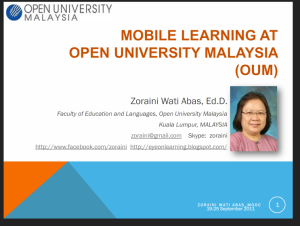The first live session of Change Mooc lived up to expectations. Without a ‘go with the flow’ mindset (i.e. open to unpredictable events) it would have been very frustrating. Could we say that this ‘go with the flow’ attitude is going to be an essential ingredient of effective learning in the 21st century – or would that be a step too far?
Big Blue Button failed to cope with the 63 people who showed up and crashed. However, my past experience of BBB has been good, so I would still use it for smaller groups. It is open source and still developing.
True to the spirit of distributed learning, this BBB crash did not prevent the show from going on. Between Facebook, Twitter and the offer by a participant of the use of Fuze meeting – we all eventually moved over and the presentation went ahead – albeit very late for Zoraini who probably didn’t get to bed until near on 2.00 am.
Information about Zoraini’s presentation and associated papers can be found here – http://change.mooc.ca/week02.htm – and the recording http://change.mooc.ca/presentation/1
22000+ students have benefited from mobile learning in Malaysia, which is used principally to reduce drop out rates from open and distance learning courses, even though these courses are blended. Retention has always been an issue in distance learning programmes. The Open University of Malaysia having first experimented with podcasting which students didn’t respond to because of the associated costs, now uses SMS to keep students informed about course content, provide them with reminders and tips on how to study effectively, motivate them and for course management. Response from students has been very positive (details and figures are in the presentation slides).
But most interesting for me in this session was that it sparked a question in the chat room as to whether this form of mobile learning, where the principle form of communication is unidirectional SMS from tutor to student, encourages student dependence, learned helplessness and decreases the potential for learner autonomy.
Zoraini’s response was quick and unhesitating. She said that SMS is used to help students develop the habits and skills necessary to be effective distance learners.
This echoes the concerns that have been raised already in some blogs – (e.g. Robert Maxwell – http://bioram-changemoocresponse.blogspot.com/ and others) about whether learning in MOOCs can be accessed by all learners, or whether there needs to be more support and ‘teacher’ intervention for ‘newbies’.
As Lisa Lane has written here – https://jennymackness.wordpress.com/2011/09/16/definitions-diversity-emergent-learning-and-responsibility-in-moocs/ in the comment on Sept 21st at 3.00 am …
We are indeed dealing with the difficulty of balancing guidance and freedom in the teaching online class.
As the use of technologies becomes less of an issue and approaches such as the use of SMS for mobile learning become ubiquitous – our attention must now move to an increased focus on pedagogy. How will the use of these technologies affect learners’ abilities to learn? How will teachers and facilitators need to change their existing practice?

Hi Jenny,
Provoking problems and questions and it’s only week 1. Good stuff.
How will value be perceived for that guided or untethered success? Will learning paths be valued differently? After fully guided 101, the design phase, weaned off and then moving towards independence, much like now.
But unlike now, open artefacts, that float and stick, will have social currency. Is crowd sourced recognition of self guided learning enough though? Will heritage institutes become final arbiters or box ticking mandates for this portfolio of evidence post viral? Self and crowd sourced put forward for an option of lowest tender, paid certification. Governments, or The Bill Payers, will be pleased if they can corner that market, before Pearson do.
BYO CPU is a given, connectivity costs solved allows the learner to demand more as they pull in or ignore data, and offers of guidance, as required. #Change11 is apt as irrelevancy or agility is The New Offer, to blended learning spaces. Guides who can, will, Institutes who offer “value”, will, but who dispenses accreditation, especially as graduate growth is needed, will be vested and vexed.
Hi Tony – thanks for your comment, with lots of good questions.
>How will value be perceived for that guided or untethered success?
>Is crowd sourced recognition of self guided learning enough though?
>who dispenses accreditation
I think all these questions would be good to explore further. It’ll be interesting to see what comes out of the research group meeting.
Jenny